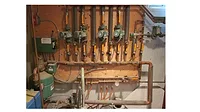Hybrid Gone Wrong

The Glitch
Overview: A system for supplying several zones of space heating using series-connected fin-tube baseboard is shown below. The intent is to also supply lots of hot water from the large (80-gallon) indirect water heater.Exercise: The installer feels that a mix of primary/secondary piping along with some “alternative techniques” is appropriate. See if you can find at least eight details (or major design errors) in this layout.

The Fix
Here’s a listing of what’s intentionally shown incorrectly:1. Boilers need individual circulators with check valves.
2. Distribution system is an “undefined” collection of secondary and “across the header” circuits.
3. “Primary loop” circulator is pumping toward expansion tank connection.
4. Heat exchanger connections on indirect tank are reversed (not counterflow).
5. Piping and circulator serving indirect tank cannot convey flow needed for 400,000 Btu/hr heat transfer.
6. Indirect tank is located on cool end of “primary loop.”
7. Long series circuits of baseboard make sizing difficult.
8. Purge valves on some circuits are incorrectly shown.
A far better approach is shown in The Fix drawing. Instead of series-connected baseboards, it uses manifolds and homerun circuits to individual baseboards. This provides the same water temperature to each baseboard and simplifies sizing. The option of thermostatic radiator valves for room-by-room temperature control is now possible.
This is not a primary/secondary system. The closely spaced tees provide hydraulic separation between the “short/fat” headers and the boiler piping, but no primary circulator is required. The indirect tank shows a large internal heat exchanger capable of sinking the full 400,000 Btu/hr boiler output into the DHW load. This coil is piped for counterflow heat exchange (in at top, out at bottom). This tank can also be operated as a priority load.
Links
Looking for a reprint of this article?
From high-res PDFs to custom plaques, order your copy today!








